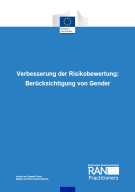Details
- Publication date
- 20 June 2024
- Author
- Directorate-General for Migration and Home Affairs
- RAN Publications Topic
- Formers
Description
Riks assessment tools developed specifically for violent extremist offenders currently miss an explicit gender dimension. Practice and research suggest that such a dimension would be necessary. Importantly, the implications of this state of fact are not only relevant for the risk assessment as such, but also in the broader context of VE management. For example, a recent UNODC specialised handbook focused on the gender dimension observes:
Risk assessment tools are most often developed for male offenders, without taking into account the gender-specific needs of women – an omission which frequently results in women being placed in higher security settings than appropriate to the level of risk they represent.
Why should gender be a consideration in risk assessment? Before addressing this question, it is important to differentiate between two main aspects of the underlying understanding of gender: as ‘women’ and as ‘gender roles’. Following these dimensions, there is first of all the assumption that there are particularities of women’s radicalisation. Consequently, it is assumed that these specific features would be relevant to risk assessment, rehabilitation and reintegration. Following this argumentation, they should also be captured in risk assessment tools. Secondly, it is assumed that factors of risk might also be influenced by the way in which gender roles are pictured in extremist propaganda, since they might influence motivation and behaviour more broadly.
From a practical perspective, if aspects that capture women’s particular experiences and gender roles are not operationalised, situations of biased assessment might arise. Some examples here can be false negatives: when women are eroneously considered less dangerous than men; or when tasks performed by women are assessed as less relevant for the degree of radicalisation they might have reached. False positives can also occur, such as when men might be considered more high-risk due to the fact that they exercised typical masculine roles (such as wearing a weapon or having fought). Their actual or cognitive radicalisation might be, however, superficial or they might have, in the meantime, effectively disengaged.

